RUSSIAN BUSINESS SURVEYS BULLETIN
INDUSTRY
84 SURVEY - MAY 1999
INSTITUTE FOR THE ECONOMY IN TRANSITION Director: Yegor Gaidar
5, Gazetny per, Moscow 103918 Russia
Tell: (+7 095) 229-93-91, Fax: 203-88-16
E-mail: tsukhlo@iet.ru


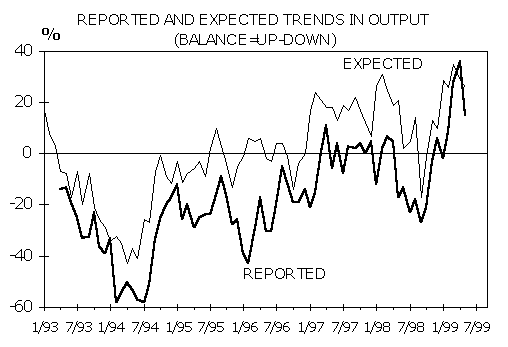
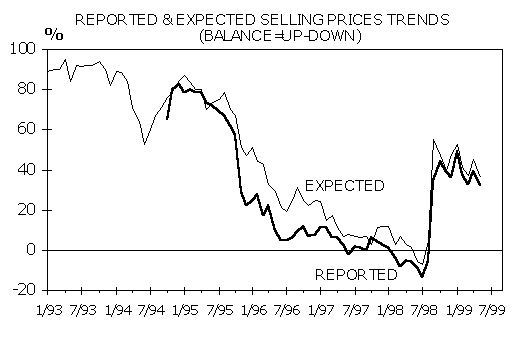
- For the third month running, the survey register an absolute growth in effective demand.
- Decrease in barter demand continues.
- Enterprises experience an increasing lack of finished goods in stock.
- Estimates of change in output continue to decline for the second month running.
Business Survey Results of 1012 Enterprises.
May 1999
(percentages of total answers)
| What has been the trends over the PAST 2-3 months: |
Up |
Same |
Down |
N/A |
Balance |
| Volume of output |
33 |
48 |
18 |
1 |
+15 |
| Average prices |
35 |
61 |
3 |
1 |
+32 |
| Order-books level (effective) |
22 |
66 |
11 |
1 |
+11 |
| Order-books level (barter) |
8 |
65 |
18 |
9 |
-10 |
| Do you consider that in volume terms: |
Above normal |
Nor-
mal |
Below normal |
N/A |
Balance |
| Your present production |
1 |
30 |
68 |
1 |
-67 |
| Your total order book |
4 |
23 |
71 |
2 |
-67 |
| Your export order book |
2 |
30 |
39 |
29 |
-37 |
| Your present stocks of finished goods |
17 |
35 |
40 |
8 |
-23 |
| What are the expected trends for the NEXT 2-3 months: |
Up |
Same |
Down |
N/A |
Balance |
| Volume of output |
37 |
50 |
11 |
2 |
+26 |
| Average prices |
38 |
56 |
2 |
4 |
+36 |
| Volume of order book level(effective) |
23 |
61 |
11 |
5 |
12 |
| Volume of order book level (barter) |
9 |
58 |
21 |
12 |
-12 |
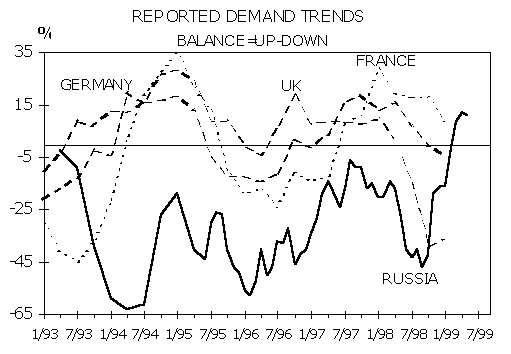
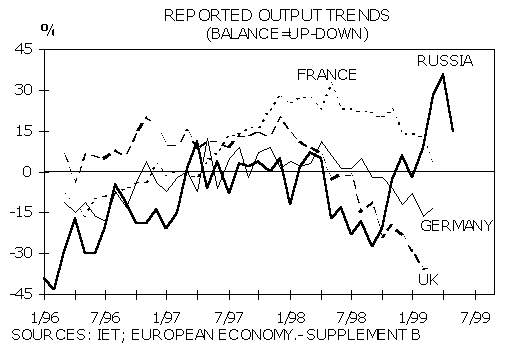
Assessment of current situation
For the third month running, the survey register an absolute growth in
effective demand. In May, reports regarding growth in sales prevail in all the industry
branches, except for the wood-working, light and food sectors. The growth pace was highest
in the ferrous metallurgy, chemicals and petrochemicals. The share of estimates of the
demand volume as normal grew up to 23% and became the best index registered since early
1995.
Decrease in barter demand which started yet in March still continues.
In May, the growth in barter transactions was registered only in the industry of
construction materials, while other industry branches show prevalence of responses
regarding a fall in such transactions.
The growth in industrial output continues, however, in May its
intensity fell notably. The respective fall was noted in all the industry branches, but
the non-ferrous metallurgy and construction industry, while an absolute downfall of output
was reported only by the forestry, paper and pulp, wood-working, and light industry
branches.
Enterprises experience an increasing lack of finished goods in stock.
In May, only 17% of enterprises estimated their stock as excessive, while in early 1994
the share of the respective responses had made up 58%. The deficit of stocks is observed
in all the industry branches, while the most substantial one is noted in the light and
machine- building sectors.
Price dynamics did not experience any significant changes in May.
Predictions and expectations
Having peaked an absolute maximal value in March, estimates of change
in output continue to decline for the second month running, however hopes for growth in
output still prevail in the industrial sector. It is the construction industry,
wood-working sector and ferrous metallurgy which project the most intensive growth in
their output, while the light and food industry branches’ projections are most
moderate.
Projections of changes in prices continue to fluctuate in the wake of
the actual price dynamics. In May, a decrease in projected values was registered in all
the industry branches, with the exception for the industry of construction materials.
Projections of change in effective demand remain generally positive -
enterprises hope for a growth in monetary sales. It is only wood-working, light and food
sectors the projections of which are negative ( fall in sales).
Projections of change in barter demand have become definitely negative
for the first time- the share of enterprises envisaging a fall in barter transactions for
the first time has exceeded the share of those ones which expect a growing number of such
transactions. Positive projections remained only in the wood-working and construction
industry branches.
May 28, 1999
Sergey Tsukhlo,
Chief, Business Surveys Department
Charts of next Issue: price expectations in subsectors
Output expectations in subsectors (balance=up-down)
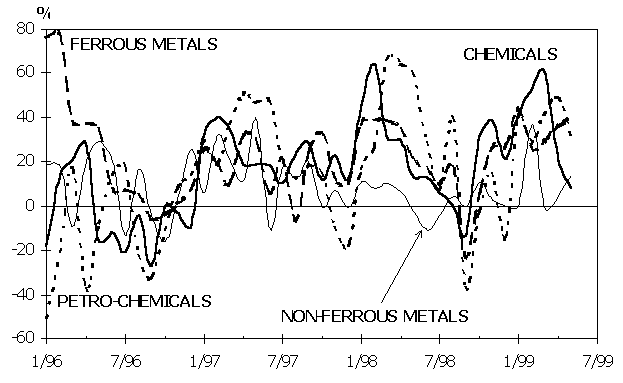
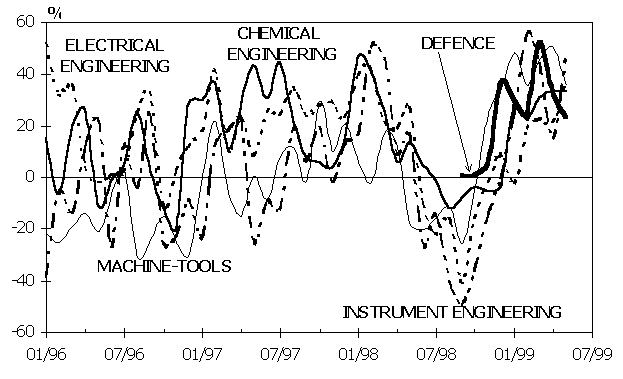
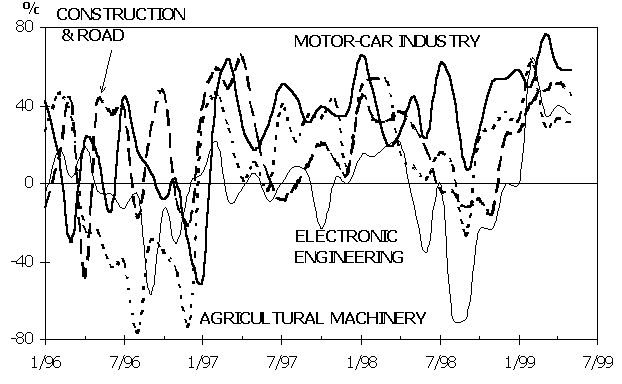
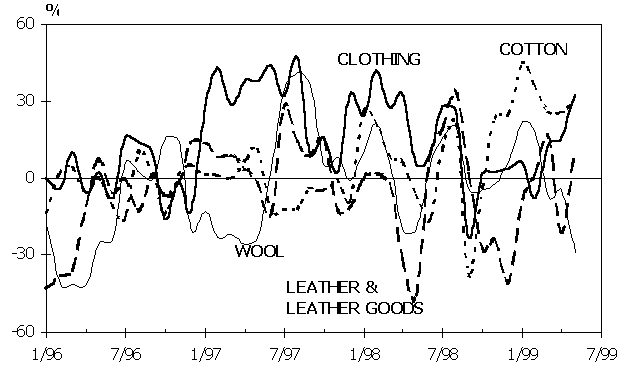
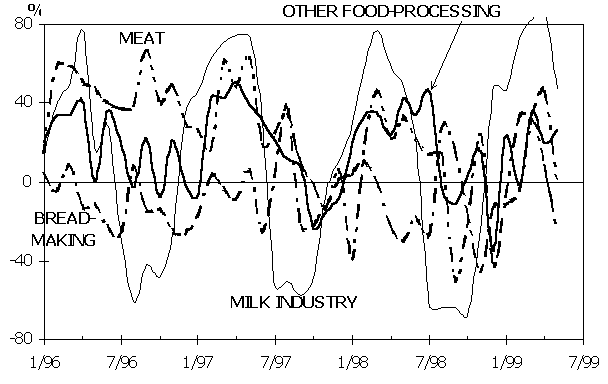
_______________________________________________________________________ |